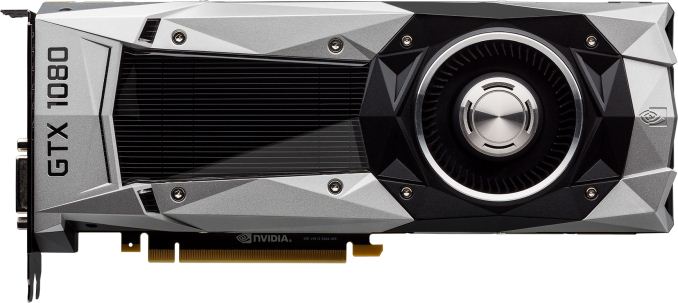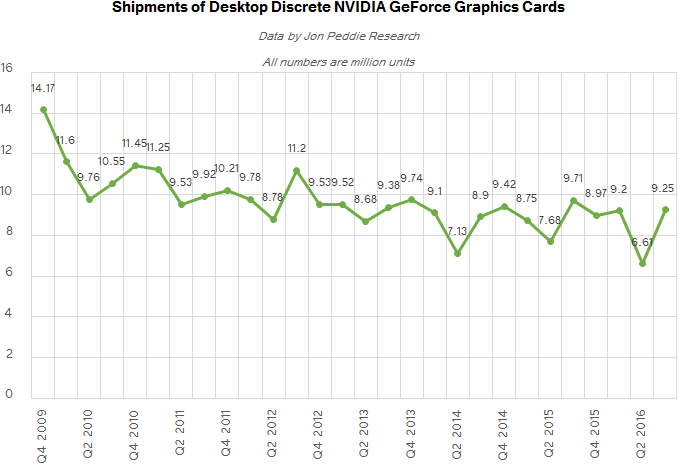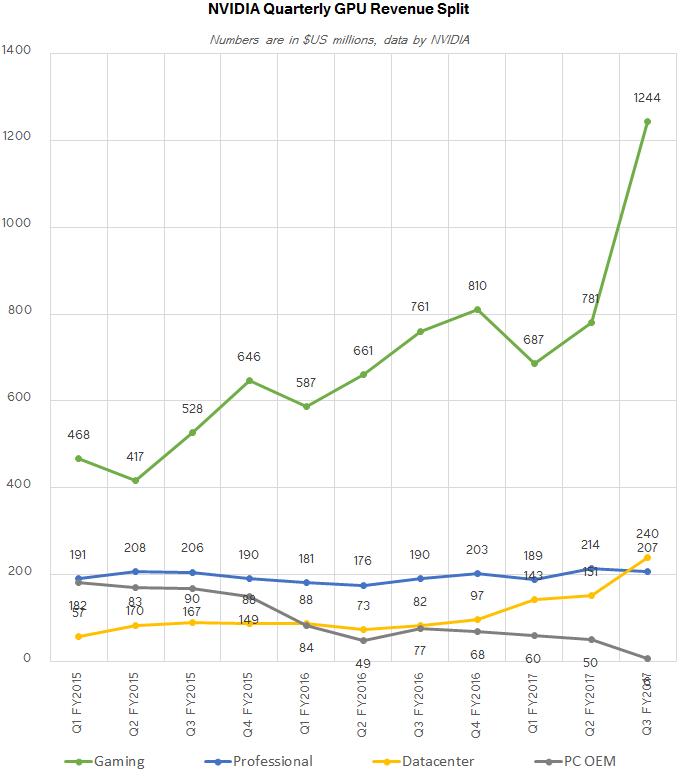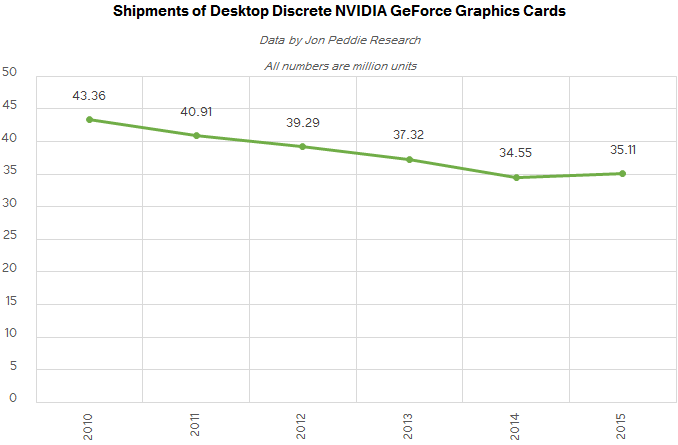Discrete Desktop GPU Market Trends Q3 2016: GPU Shipments Hit Two-Year High
by Anton Shilov on November 28, 2016 9:00 AM ESTNVIDIA: Record Sales of Gaming GPUs
Jon Peddie Research reports that NVIDIA shipped approximately 9.25 million desktop GPUs (up 39.8% QoQ) and increased its notebook GPU shipments by 38.7% sequentially in calendar Q3. NVIDIA does not officially disclose the number of graphics processors it sells, but the company’s revenue for gaming-grade GPUs skyrocketed to $1.244 billion in its Q3 FY2017 (ended October 30, 2016), so it is logical to assume that shipments of its graphics chips (both for desktops and notebooks) were very strong in the calendar third quarter as well.
“Gaming revenue crossed the $1 billion mark and increased 63% year-on-year to a record $1.24 billion, fueled by our Pascal-based GPUs,” said Colette M. Kress, CFO of NVIDIA, during the company’s earnings conference call. “Demand was strong in every geographic region across desktop and notebook, and across the full gaming audience, from GTX 1050 to the TITAN X.”
NVIDIA itself attributes its success in the third quarter to sales of its Pascal-based products — the GeForce GTX 1060, 1070 and 1080 as well as their mobile brethren. Since such boards start at $199 and their ASP should be considerably higher than that, it is not surprising that NVIDIA earned a lot despite a decrease in unit sales compared to Q3 in 2015. Unfortunately, we do not know exact rankings of AMD and NVIDIA in the enthusiast part of the market in terms of units, but it looks like the green company commands the lion’s share of this lucrative segment in terms of both units and dollars. Moreover, this situation is going to last for some time before AMD introduces its next-generation Greenland/Vega GPUs.
For the three-quarters so far in 2016, NVIDIA has sold approximately 25 million of desktop discrete GPUs. This is ~4% lower than in the first three quarters of 2015 (around 26 million). Nonetheless, despite slightly lower unit sales, the company is thriving financially due to higher ASPs. Moreover, NVIDIA’s management implies that demand for its desktop GPUs is still very high and sales of graphics cards may increase in Q4 as a result of improved yields and/or increased allocation at TSMC. If this happens, the company could sell around 35 million desktop GPUs in total this year, the same amount as in 2015.
“In terms of Pascal, we are still ramping,” said Jen-Hsun Huang, CEO of NVIDIA. “Production is fully ramped in the sense that all of our products are [certified and qualified with OEMs], they are on the market. However, demand is still high. So, we are going to continue to work hard, and our manufacturing partner TSMC is doing a great job for us.”














53 Comments
View All Comments
RussianSensation - Friday, December 2, 2016 - link
I5 2500K/2600K turn 7 years old next month, since they were released on January 2011!catavalon21 - Sunday, December 11, 2016 - link
How about splitting the difference, and call it 6 years old?Araa - Monday, November 28, 2016 - link
Never been an AMD fan myself but I hope they get out of the slumber they are currently in. I want the good ol' 2010 days back where they were a strong second.Keao - Monday, November 28, 2016 - link
Yeah and back then GPU mid-tier was a bargain :-)Aaaah I miss the days of the RADEON HD4870...
Stuka87 - Monday, November 28, 2016 - link
In 2010 AMD was in first place. Thats back when the 5000 series was king of the hill and the GTX 400 series was delayed 6 months and shipped as a power guzzling pig. It was later on when the updated 500 series brought nVidia back in front as the AMD 6000 series was just a basic re-badge.silverblue - Tuesday, November 29, 2016 - link
Not quite; the 6900 series moved from VLIW5 to VLIW4 due to AMD realising that the average slot utilisation was 3.4, hence there were efficiency gains to be made in reducing the size of each shader block. The 6870 and below were based off the 5000 series, however.just4U - Friday, December 2, 2016 - link
While the 470/80 were guzzlers for sure .. the 460 was the little darling... priced well and gave Nvidia fans something to cheer about. The 500 series certainly brought more to the table, however AMD was matching them in performance while beating them on pricing...I always remember wanting a 560Ti or a 570 but could never justify it on the price so opted for the AMD equivalent... sad to because even as it was about to be discontinued the damn cards never did come down in price. That's when I started to get a little miffed with Nvidia. After the TNT2 They really began to sock it to you price wise with the Geforce line... That's something ATi never really did... even when they were the king of graphics in the early 90s.
Strunf - Thursday, December 8, 2016 - link
ATI/AMD, nVIDIA will charge as much as they can... there are no good guys, they are quoted on the stock market and hence profit driven.In the early 90s the graphics card wasn't so important and there were a few players ATI, S3, Matrox, Intel... then the 3D accelerators kicked in and the market went crazy.
Samus - Tuesday, November 29, 2016 - link
I haven't had an AMD GPU since AMD bought ATI that I liked. They were cheaper, for the same performance as nVidia, but they failed early, the drivers were awful, and their partners were and still are lousy. AMD doesn't have an equivalent OEM builder to nVidia such as PNY or EVGA.And before you laugh about PNY, remember that PNY is actually the largest distributor of nVidia cards. By quite a lot. I remember reading a few years ago that PNY shipped more cards than every other nVidia partner COMBINED. All those Quadro's have helped their bottom line as well.
peterfares - Wednesday, November 30, 2016 - link
ASUS makes AMD cards. They're reputable.